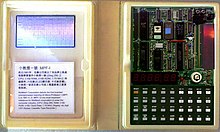This article has multiple issues. Please help improve it or discuss these issues on the talk page. (Learn how and when to remove these messages)
|
 Microprofessor I Microprofessor I | |
| Also known as | MPF-1 MPF-1A MPF-1B |
|---|---|
| Developer | Multitech |
| Manufacturer | Multitech (1981-1993) Flite Electronics International Limited (1993-) |
| Release date | 1981; 44 years ago (1981) |
| Introductory price | $149 |
| Operating system | 2 KB monitor ROM |
| CPU | Zilog Z80 @ 1.79 MHz |
| Memory | 2 KB RAM |
| Storage | Compact Cassette |
| Display | Six digit 7-segment display. |
| Sound | Beeper |
| Input | Hexadecimal calculator-type keyboard (36 keys including, 16 hexadecimal keys, 19 function keys, and one user-definable key) |
| Power | 5 V via 7805 from 9 V at 500 mA mains adapter |
| Successor | MPF-1 Plus |
The Micro-Professor MPF-I is a microcomputer released by Multitech (later renamed Acer) in 1981. The company's first branded product, it was marketed as a training system to learn machine code and assembly language for the Zilog Z80 microprocessor. After releasing several iterations of the product, Acer sold the product line to Flite Electronics in 1993.
History
In 1981 Multitech released the Micro-Professor MPF-I, a Zilog Z80 microprocessor development board enclosed in a vacuum formed plastic bookcase for storage on a bookshelf. Later Multitech introduced a Tiny-Basic for the MPF-1. The Monitor and Basic fitted into one 4 KB ROM, replacing the 2 KB monitor-only ROM. This configuration was marketed as the MPF-1B.
In 1984, Multitech introduced the MPF-1P or MPF-Plus, a successor to the MPF-1 with the same form factor. It featured a single line 20-digit, 14-segment fluorescent display and a click-type QWERTY keyboard. It had the same expansion connector as the MPF-1 (strictly a Z80-CPU pin-header), so several of the MPF-1 expansion boards could be used on the MPF-1P. It was more a BASIC computer than the MPF-1, with an assembler and disassembler as part of the 8 KB firmware. The MPF-1P featured 4 KB static RAM, with optional battery backup.
1985 saw the release of the MPF-I/88, the last product in the MPF-I line. It was an Intel 8088-based single board computer with a two-line LCD screen. Multitech was renamed Acer Inc. in 1987.
On 24 February 1993, Acer sold the Micro-Professor MPF-I product line to Flite Electronics International Limited, an international distributor for Acer based in Southampton, England. Flite is still manufacturing small batches of the MPF1B at a sub-contract manufacturing facility in Havant, England.
Product specifications
Programs are entered into the MPF-I using Z80 machine code in hexadecimal format. The MPF-I monitor program displays both an address and data stored at that address simultaneously using a seven-segment display. There is a spare DIP socket for adding additional ROM or RAM to the MPF-I. There are also two 3.5 mm audio jacks on the top right of the computer, these are to communicate with the audio cassettes that are used to store programs and code typed into the machine. One is used to read the drive and the other is used to write data; on a conventional audio cassette deck the wires would be connected to the headphone and microphone ports. This type of data storage is similar to that of a Radio Shack TRS-80 or the Sinclair ZX-81, which similarly used audio cassettes to store programs the user typed, as well as commercial programs and games the user could buy.
Modern extensions
PicoRAM 6116 is a 6116 SRAM emulator and SD card interface for the Microprofessor based on the Raspberry Pi Pico. It facilitates store and restore of complete SRAM memory dumps. PicoRAM 6116 also supports HEX files generated by Z80 assemblers, hence facilitating a modern software development tool chain by using PC-based assemblers and file transfer of the generated HEX files to the Microprofessor via SD card.
See also
- Microprofessor II — an unrelated Apple II clone made by Multitech
- Microprofessor III — an unrelated Apple IIe clone made by Multitech
References
- "Summary of Acer Milestones: Acer America". Archived from the original on 1 July 2003. Retrieved 1 May 2004.
{{cite web}}: CS1 maint: bot: original URL status unknown (link), 1981:MicroProfessor-I becomes the company's first branded product. - Flite Electronics – International Supplier of the Microprofessor Training System (archived content)
- Yet another computer museum - Multitech MPF-1
- "Computer Data Cassette Formats". retrotechnology.com. Retrieved 25 October 2019.
External links
- "The Micro-Professor" (PDF). Byte. Vol. 7, no. 8. McGraw-Hill. 1982. p. 127.
- Flite Electronics – International Supplier of Microprocessor Training Systems and owner of the overall copyright of the MPF range of products
- A tribute to the Microprofessor System
- MPF-I User's manual
- PDF documentation and ROM dumps for the Multitech MPF-1 computer
| Acer Inc. | |||||||||||||||||||||
|---|---|---|---|---|---|---|---|---|---|---|---|---|---|---|---|---|---|---|---|---|---|
| Brands | |||||||||||||||||||||
| Products |
| ||||||||||||||||||||
| Other | |||||||||||||||||||||